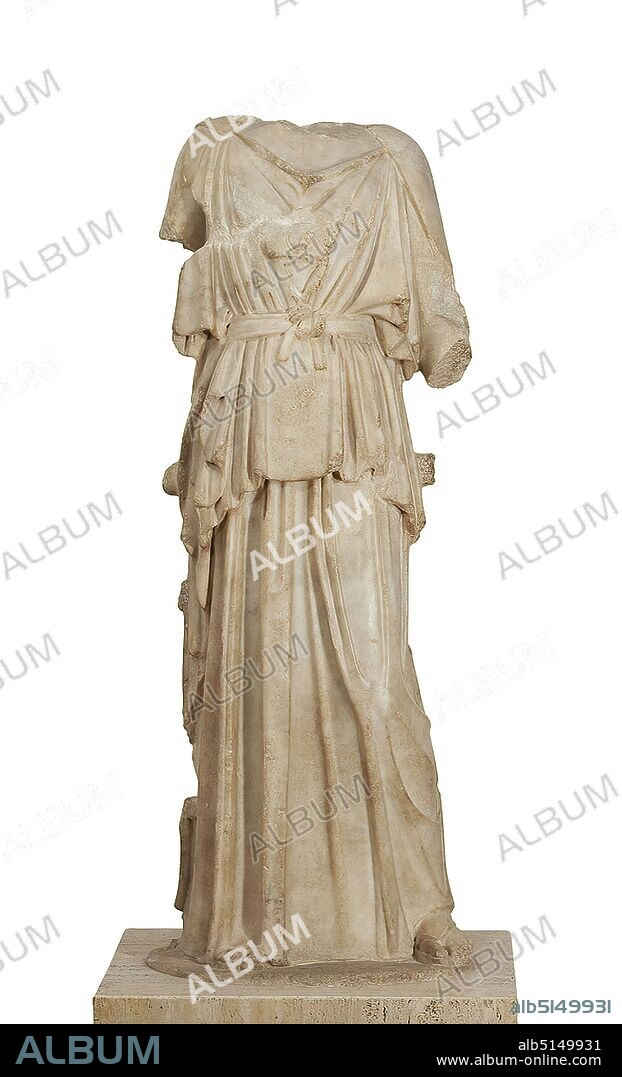alb5149931
Myron, Statue of the goddess Athena (copy after Athena-Marsyas group of Myron), Property of the Stiftung Hamburger Kunstsammlungen, Marble, chiseled, Total: Height: 143,5 cm; Width: 52 cm; Depth: 41 cm, Three-dimensional sculptures, Olympic gods, History of Marsyas, High Classical period (Greek antiquity), The female figure is dressed with a peplos and wears sandals The Gorgoneion - the small fright image on her chest framed by snakes - identifies her as the statue of Athena. On the plinth there are remains of red paint. Although the original of this figure is lost, it can be reconstructed: The model, erected around 440 BC on the Acropolis of Athens, was part of a two-figure group by the famous arch sculptor Myron from Eleutherai. It showed the goddess together with the satyr Marsyas in a well-known mythological scene. Athena had invented the game with the Auloi (flute). She enjoyed its sound until she realized in the mirror of a body of water that the swollen cheeks, reddened from exertion, disfigured her face. Horrified, she threw the flute away and cursed anyone who picked up the instrument. The fact that the satyr Marsyas - a wild creature with a horse's tail and ears from Dionysus' entourage - nevertheless reached for the flute was to be his undoing. His presumption drove him to the musical competition with Apollo, whose playing on the kithara (harp-like instrument) he wanted to surpass with the flute. But Apollon remained the victor and had him hung on a tree and skinned alive as punishment. It was once a lavish monument, which on the Acropolis of Athens brought the myth of Athena and Marsyas to life, and the Athenians had it erected for a reason. The disputes between Athens and Boeotia, the landscape north of Attica, gave rise to this. Athena throws away the flute, demonstrating the contempt of the city of Athens for the lower art of flute playing. Marsyas, on the other hand, who is about to pick up the flute, stands for the uncultivated, peasant province of.

|
Añadir a otro lightbox |
|
Añadir a otro lightbox |



¿Ya tienes cuenta? Iniciar sesión
¿No tienes cuenta? Regístrate
Compra esta imagen.
Selecciona el uso:

Descripción:
Ver traducción automática
Myron, Statue of the goddess Athena (copy after Athena-Marsyas group of Myron), Property of the Stiftung Hamburger Kunstsammlungen, Marble, chiseled, Total: Height: 143,5 cm; Width: 52 cm; Depth: 41 cm, Three-dimensional sculptures, Olympic gods, History of Marsyas, High Classical period (Greek antiquity), The female figure is dressed with a peplos and wears sandals The Gorgoneion - the small fright image on her chest framed by snakes - identifies her as the statue of Athena. On the plinth there are remains of red paint. Although the original of this figure is lost, it can be reconstructed: The model, erected around 440 BC on the Acropolis of Athens, was part of a two-figure group by the famous arch sculptor Myron from Eleutherai. It showed the goddess together with the satyr Marsyas in a well-known mythological scene. Athena had invented the game with the Auloi (flute). She enjoyed its sound until she realized in the mirror of a body of water that the swollen cheeks, reddened from exertion, disfigured her face. Horrified, she threw the flute away and cursed anyone who picked up the instrument. The fact that the satyr Marsyas - a wild creature with a horse's tail and ears from Dionysus' entourage - nevertheless reached for the flute was to be his undoing. His presumption drove him to the musical competition with Apollo, whose playing on the kithara (harp-like instrument) he wanted to surpass with the flute. But Apollon remained the victor and had him hung on a tree and skinned alive as punishment. It was once a lavish monument, which on the Acropolis of Athens brought the myth of Athena and Marsyas to life, and the Athenians had it erected for a reason. The disputes between Athens and Boeotia, the landscape north of Attica, gave rise to this. Athena throws away the flute, demonstrating the contempt of the city of Athens for the lower art of flute playing. Marsyas, on the other hand, who is about to pick up the flute, stands for the uncultivated, peasant province of
Personas:
Crédito:
Album / quintlox
Autorizaciones:
Modelo: No - Propiedad: No
¿Preguntas relacionadas con los derechos?
¿Preguntas relacionadas con los derechos?
Tamaño imagen:
2624 x 4320 px | 32.4 MB
Tamaño impresión:
22.2 x 36.6 cm | 8.7 x 14.4 in (300 dpi)
Palabras clave:
ACROPOLIS • AGUA • ALEGORIA • APOLO (DIOS) • ARBOL • ATENAS • ATENEA • BARCO • BARCOS • BEOCIA • BODY • CADAVER • CAMINO • CARA • CASTIGO • CHARLAR • CINCELADO • CIUDAD • CONVERSACION • CONVERSANDO • CONVERSAR • COPIA • CUERPO • DISCUSION • EMOCION • EN • ENROJECIDO • ESCENA MITOLOGICA • ESPEJO • ESTATUA • FACE • FIGURA FEMENINA • FIGURA • FLAUTA • FUTURO • HABLANDO • HABLAR • HISTORIA • INSTRUMENT • INSTRUMENTO • JUEGO • JUGANDO • JUGAR • MALDICION • MALEFICIO • MANO • MANOS • MARBLE • MARMOL • MARSIAS • MITO • MITOLOGIA • MODELO • MOSTRANDO • MOSTRÓ • MYRON • NAVES • OÍDOS • ORIGINAL • PEPLO • PEPLUM • PERDIDO • PROFUNDIDAD • RAZON • ROSTRO • SENSACION • SENTIMIENTO • SENTIR • SERVIR • STATUE • TALKING • TESTAMENTO • TIRO • ULTIMA VOLUNTAD • VIDA • WANTED
 Pinterest
Pinterest Twitter
Twitter Facebook
Facebook Copiar enlace
Copiar enlace Email
Email
